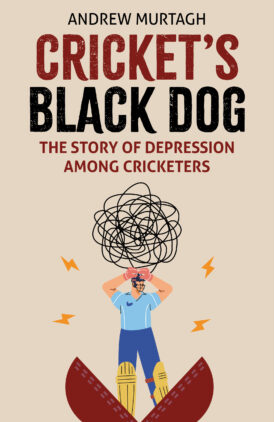Cricket’s Black Dog
Martin Chandler |Published: 2025
Pages: 254
Author: Murtagh, Andrew
Publisher: Pitch
Rating: 4 stars

The name of Andrew Murtagh is a familiar one, and when I realised what this book was about I decided to remind myself what I knew about him. His main claim to fame for me is as the writer of a number of decent cricketing biographies in recent years. His subjects have been George Chesterton, Colin Cowdrey, Tom Graveney, Tony Greig, John Holder and Barry Richards. The latter two were Hampshire teammates, and Chesterton a colleague at Malvern College.
So before embarking on a writing career Murtagh had initially been a professional cricketer himself, spending five summers on the Hampshire staff. His First Class career figures are modest, spread over just 27 matches. His record in the old Sunday League was better and, as an avid viewer of BBC2’s weekly coverage of that competition I remember him well. He was 29 when he was released and it wasn’t until the Chesterton biography appeared just over a decade ago that I realised he had then joined Malvern to teach English.
What I had the means of knowing, but had not actually twigged, was that Murtagh had retired from teaching at the age of 51. I had blithely assumed he had, as would of course be entirely possible, combined his teaching and writing careers for a number of years before finally leaving Malvern when he was in his sixties.
It turns out that, like many others, Murtagh has spent a large part of his life battling depression. At the time he left teaching mental health problems were not ones that sufferers shared. A few years later however Marcus Trescothick published his ground breaking autobiography laying bare the details of his struggles, a book that has been followed by a number of others and, generally, a much greater awareness of the prevalence of such issues.
The themes of cricket and mental health have been visited before, in David Frith’s two studies of cricketers who have taken their own lives, but both of his books appeared in the last century. As noted the subject has moved on, and the stigmas of old have been swept away. After the stories that have been told in recent years a reappraisal of the subject is certainly welcome, and a skilled and experienced writer with experience of both aspects is surely the man ideally qualified for the project.
So Cricket’s Black Dog is, in part, an autobiography, but perhaps could usefully have contained more of Murtagh’s own story. He certainly explains what he has been through, and his experience of the treatment he received, but little more. The reason for that is doubtless a desire to respect the privacy of those close to him, and for a man who, when hospitalised, was reluctant to discuss his problems with any of those treating him it cannot in any event have been easy to open up about his own demons to the extent that he does.
As part of his analysis Murtagh looks closely at the stories of many cricketers, some from the past, particularly the fascinating story of Walter Hammond, but more from the modern era where, unlike Hammond, those involved have told their stories themselves. Credit too to Graeme Fowler for taking the trouble to speak to Murtagh to supplement what he has written in his books, Absolutely Foxed and Mind Over Batter. It is a shame Trescothick did not do likewise, but as Murtagh himself opines such is the amount of material in his own book and in interviews he has subsequently given that he may well have had little to add.
Is the absence of any input from experts in the fields of psychology or psychiatry a failing in the book? It was something I kept expecting but there is nothing. Ultimately I remain of the view that a few thoughts from such men or women would have been interesting, but equally I doubt that it would have added a great deal. One thing that is clear is that whilst there are common features in many of the case studies that Murtagh carries out the reality is that no two cases are the same, and solutions that are successful with some are not with others.
The book, as it was always going to, ends with a concluding chapter entitled So, What is the Answer? There is no magic bullet or single answer of course, as Murtagh immediately concedes, but Cricket’s Black Dog is nonetheless an immensely readable look at a question that will, hopefully, be much more likely to be answered in the future if the discussion that Murtagh starts continues to be acknowledged, studied and worked on. For now though the best answer comes with Murtagh’s final words:-
Cricketers die twice. I guess it’s a case, and always has been, of how we fare in the second innings.






On your point about the absence of input from a psychiatrist in this book, Martin, I’m reminded of Mike Brearley’s absorbing Foreword to Frith’s book, Silence of the Heart (2001). Two and a half pages, written in September 2000 – so qualifying for the New Millennium. It’s always interesting to try and second guess what “Brains Brearley” (as my kids used to call him) is going to say and then confronting the actual thing!
A comparison with film stars and musical pop stars ending their own lives would, I expect, be fascinating.
PK
Comment by PETER BARRINGTON KETTLE | 10:03am BST 12 June 2025